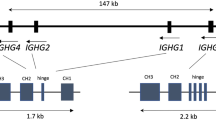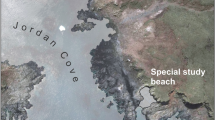Abstract
The immunoglobulin heavy chain loci of the mouse contain eight tightly linked genes that encode the constant region (C) of the immunoglobulin heavy chains (H). As no recombination occurred within the immunoglobulin CH gene loci among more than 3,000 crosses of mice1–3, the mouse CH genes were believed to be inherited as a set, designated the Igh haplotype. Recent molecular cloning experiments4–9 have demonstrated that the organization of the mouse Igh loci of BALB/c (Igha haplotype) is 5′-Cμ-(4.5 kilobases [kb])-Cδ-(55kb)-Cγ3-(34kb)-Cγ1-(21 kb)-Cγ2b-(15 kb)-Cγ2a-(14 kb)-Cɛ-(12 kb)-Cα-3′. The structural analyses of four Cγ subclass genes have shown that they are essentially identical in terms of lengths and locations of each of the structural and intervening sequences6,10–12. Comparison of the nucleotide sequences of the Cγ1, Cγ2b and Cγ2a genes has shown that limited portions of the Cγ gene are conserved between compared pairs of the Cγ genes12. The results imply that the nucleotide sequences of the Cγ gene segments have been exchanged by recombination among related clustered genes. Similar studies on the Cγ2a genes of different haplotypes, Igha and Ighb, have also suggested that these two types of Cγ2a gene have undergone recombinational exchange of a part of the gene sequence13. These results imply, in contrast to the previous belief, that frequent recombinational events have taken place within the Igh loci and that their nucleotide sequences have been rearranged during evolution. Here we present direct evidence that a Japanese wild mouse, Mus musculus molossinus, contains duplicated Cγ2a genes while the copy numbers of the neighbouring CH genes, that is, the Cγ1, Cγ2b and Cɛ genes, remain constant. The results indicate that the duplicated Cγ2a genes of M. m. molossinus arose from unequal crossing-over between homologous chromosomes.
This is a preview of subscription content, access via your institution
Access options
Subscribe to this journal
Receive 51 print issues and online access
$199.00 per year
only $3.90 per issue
Buy this article
- Purchase on Springer Link
- Instant access to full article PDF
Prices may be subject to local taxes which are calculated during checkout
Similar content being viewed by others
References
Herzenberg, L. A. Cold Spring Harb. Symp. quant. Biol. 29, 455–462 (1964).
Lieberman, R. & Potter, M. J. molec. Biol. 18, 516–528 (1966).
Potter, M. & Lieberman, R. Adv. Immun. 7, 91–145 (1967).
Shimizu, A. et al. Nature 289, 149–153 (1981).
Nishida, Y. et al. Proc. natn. Acad. Sci. U.S.A. 78, 1581–1585 (1981).
Honjo, T. et al. Immun. Rev. 59, 33–67 (1981).
Liu, C.-P., Tucker, P. W., Mushinski, G. F. & Blattner, F. R. Science 209, 1348–1353 (1980).
Roeder, W., Maki, R., Traunecker, A. & Tonegawa, S. Proc. Natn. Acad. Sci. U.S.A. 78, 474–478 (1981).
Shimizu, A., Takahashi, N., Yaoita, Y. & Honjo, T. Cell 28, 499–506 (1982).
Honjo, T. et al. Cell 18, 559–568 (1979).
Yamawaki-Kataoka, Y., Kataoka, T., Takahashi, N., Obata, M. & Honjo, T. Nature 283, 786–789 (1980).
Yamawaki-Kataoka, Y., Miyata, T. & Honjo, T. Nucleic Acids Res. 9, 1365–1381 (1981).
Schreier, P. H., Bothwell, A. L. M., Mueller-Hill, B. & Baltimore, D. Proc. natn. Acad. Sci. U.S.A. 78, 4495–4499 (1981).
Lieberman, R. & Potter, M. J. exp. Med. 130, 519–541 (1969).
Yonekawa, H. et al. Jap. J. Genet. 55, 289–296 (1980).
Moriwaki, K., Shiroishi, T., Minezawa, M., Aotsuka, T. & Kondo, K. J. Immunogenet. 6, 99–113 (1979).
Minezawa, M., Moriwaki, K. & Kondo, K. Jap. J. Genet. 56, 27–39 (1981).
Loghem, E. van. et al. J. Immunogenet. 7, 285–299 (1980).
Matumoto, H. et al. Jap. J. hum. Genet. (in the press).
Yaoita, Y. & Honjo, T. Nature 286, 850–853 (1980).
Southern, E. M. J. molec. Biol. 98, 503–517 (1975).
Maniatis, T., Jeffrey, A. & Kleid, P. G. Proc. natn. Acad. Sci. U.S.A. 72, 1184–1188 (1975).
Author information
Authors and Affiliations
Rights and permissions
About this article
Cite this article
Shimizu, A., Hamaguchi, Y., Yaoita, Y. et al. Japanese wild mouse, Mus musculus molossinus, has duplicated immunoglobulin γ2a genes. Nature 298, 82–84 (1982). https://doi.org/10.1038/298082a0
Received:
Accepted:
Issue Date:
DOI: https://doi.org/10.1038/298082a0
This article is cited by
Comments
By submitting a comment you agree to abide by our Terms and Community Guidelines. If you find something abusive or that does not comply with our terms or guidelines please flag it as inappropriate.



